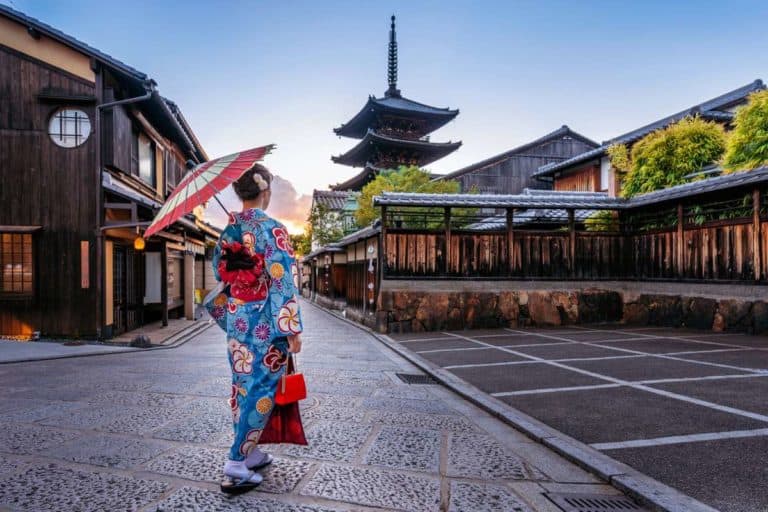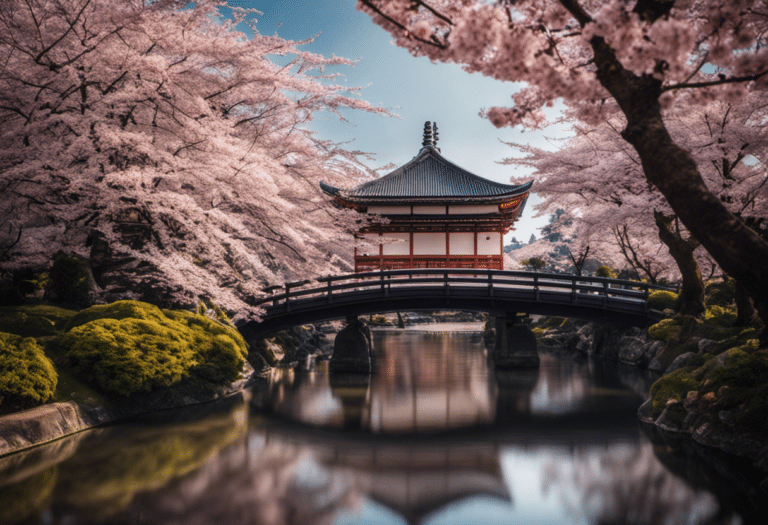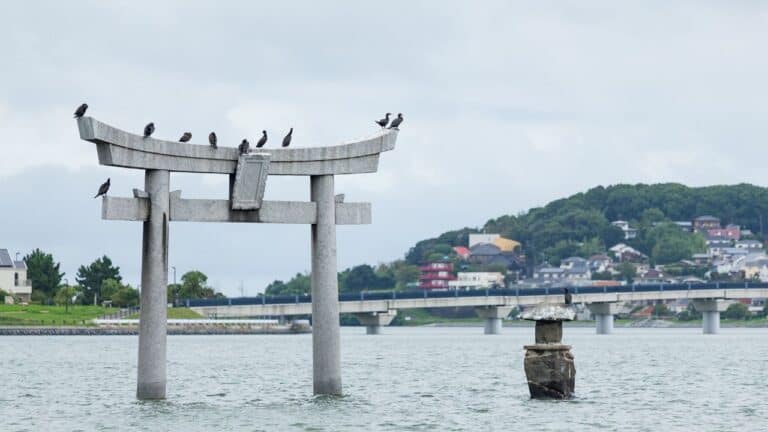Top 11 Best Aquariums in Japan
For many people, Japan is an exotic destination where one can enjoy the sights and sounds of Japanese culture.
For others, it’s a place to go for business or study. But for those genuinely adventurous, Japan has something else in store: some of the most amazing aquariums in the world!
There are so many aquariums in Japan that choosing which ones to visit can be hard.
That’s why we’ve compiled a list of the 11 best Japanese aquariums for you! It will save you time and money, but more importantly, it’ll ensure your trip is unforgettable!
The following are just some of our favorites from around Japan:
As an Amazon Associate and Booking affiliate, LoveForTraveling.com earns from qualifying purchases. We may receive a commission for purchases made via our links.
1) Osaka Kaiyukan Aquarium
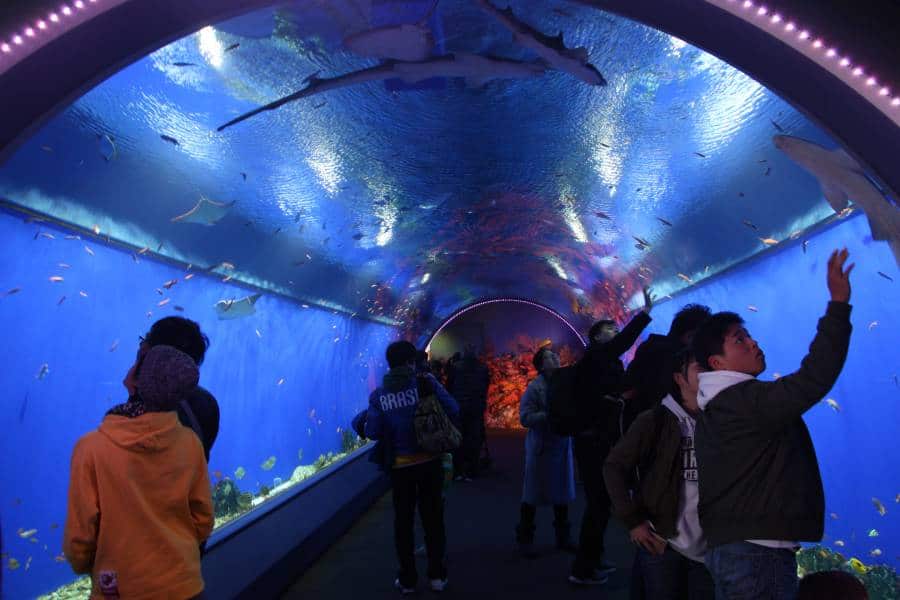
Osaka Aquarium Kaiyukan is located in Dotonbori, part of the famous Osaka tourist district.
The aquarium has more than 29,000 fish and over 420 species on display (including some rare specimens).
Located indoors and over three stories high, the Osaka Aquarium is one of the most popular aquariums in Japan.
The tanks at the Osaka Aquarium are divided by theme.
They include “Aquabeat,” which is entirely dedicated to jellyfish, “Waters of the World,” which features marine life encountered in different areas around the world (including Taiwan), as well as 4D cinema experience with high definition images.
The aquarium also features a dolphin show and is the only public facility in Japan to allow visitors to touch dolphins.
The Osaka Aquarium Kaiyukan is most prevalent during the summer months due to its large outdoor pool with a giant whale shark as an attraction.
More than half of Japan’s paid marine park visits occur at the Osaka Aquarium Kaiyukan.
- Admission Fee: 2,550 yen for adults and 1,300 yen for children
- Open Hours: 9 AM to 7 PM daily
- Address: 1 Chome-1-10 Kaigandori, Minato Ward, Osaka, 552-0022, Japan
Be sure to go early as the Osaka Aquarium gets exceptionally crowded in the evenings, particularly during summertime when it is frequented by large groups of school children on field trips.
2) Toba Aquarium
The Toba Aquarium is one of the biggest aquariums in Japan, featuring 25 tanks and more than 25,000 fish worldwide.
The aquarium opened in 2008 and has since attracted thousands of visitors a day during summer.
More recently, in 2013, it was voted one of the top 100 attractions in Japan.
The Toba Aquarium features a variety of exhibits, including spider crabs, freshwater eels, and seahorses.
Visitors can also view the ocean floor at the aquarium’s dedicated tunnel tank, which provides an underwater experience without needing scuba gear.
The Toba Aquarium also features a dolphin show, but visitors are prohibited from touching the dolphins, unlike other facilities in Japan.
The aquarium has one of the giant tanks in Japan, where visitors can watch whale sharks swim above their heads.
- Admission Fee: 2500¥ for adults; 1300¥ for children
- Open Hours: 9 AM to 5 PM daily
- Address: 3 Chome-3-6 Toba, Mie 517-8517, Japan
3) Okinawa Churaumi Aquarium
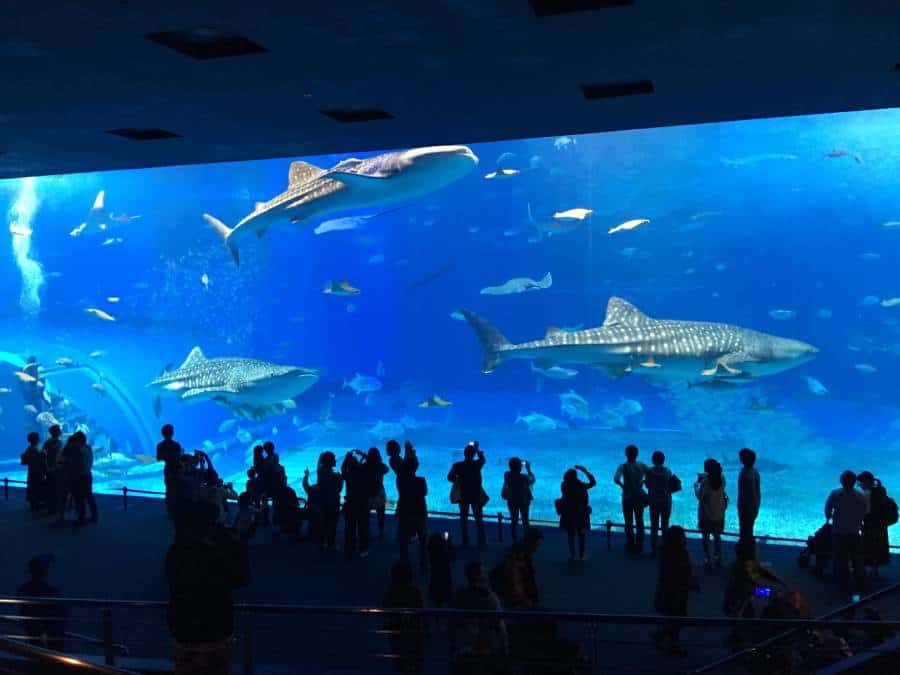
Located in Okinawa, the Okinawa Churaumi Aquarium is one of Japan’s best aquariums. The facility was established in 2001 and featured over 30 tanks with marine life worldwide.
The main attraction at the Churaumi Aquarium is its massive whale shark tank – here; visitors can get a close look at the whale sharks.
The aquarium also features various other displays, including the 3D theatre featuring a submarine and different sea life from around Japan.
The Okinawa Churaumi Aquarium is one of the biggest attractions in Okinawa, attracting over 1 million visitors annually.
- Admission Fee: 1880¥ for adults; 620¥ for children
- Open Hours: 8:30 AM to 4 PM daily
- Address: 424 Ishikawa, Motobu, Kunigami District, Okinawa 905-0206, Japan
4) Tokyo Sumida Aquarium
The Tokyo Sumida Aquarium is one of the largest public aquariums in Japan, featuring more than 7,000 fish worldwide.
The aquarium was established in 1935 and is one of the oldest public facilities of its kind.
The Sumida Aquarium has long been a popular attraction for visitors to Tokyo, attracting more than 2 million visitors annually. Recent years have seen a rise in tourist numbers due to the aquarium’s promotion as part of the “One Day In Japan” campaign.
The main attraction at the Tokyo Sumida Aquarium is its dolphin show, where visitors can witness a pod of dolphins swimming alongside a group of trainers every 30 minutes.
The aquarium also features other marine life tanks around Japan, including the sea anemone tank and jellyfish exhibits.
Some of the aquarium’s most beloved fish include the sea turtles, which reside in a circular tank.
The Sumida Aquarium is also unique for its dolphin feeding sessions, where visitors are encouraged to throw fish into the water at feeding time.
- Admission Fee: 2300¥ for adults; 1100¥ for children
- Open Hours: 10 AM to 8 PM daily
- Address: Japan, 〒131-0045 Tokyo, Sumida City, Oshiage, 1 Chome−1−2
5) Umitamago Aquarium
The Umitamago Aquarium is located in Hiroshima and features more than 20,000 fish from across the globe.
Established in 2001, the facility attracts around 1 million visitors a year.
The Umitamago Aquarium provides an experience to visitors that is similar to scuba diving without needing actual diving gear.
One of the main attractions at the Umitamago Aquarium is its 30-meter underwater tunnel which leads visitors through more than 50 tanks filled with marine life.
The facility also features exhibits, including an ocean tank containing Pacific Ocean aquatic life.
The Umitamago Aquarium also holds dolphin shows for visitors during certain days of the week.
The shows are free but have limited capacity during peak tourist season, so making reservations in advance is recommended.
- Admission Fee: 2300¥ for adults; 1150¥ for children
- Open Hours: 9 AM to 6 PM daily
- Address: Japan, 〒870-0802 Oita, Kanzaki
6) Aquamarine Fukushima
Located in the Fukushima Prefecture, Aquamarine Fukushima features various exhibits featuring marine life worldwide.
The facility opened in 2001 and is one of Japan’s most popular aquariums.
Overseen by Toshihiko Kinoshita, an accomplished film actor and director, the aquarium has been praised for its shows and interactive displays, which have been designed to appeal to younger visitors.
The main attraction at the Aquamarine Fukushima is its whale shark tank visitors can get a close look at this massive sea creature.
It has one of the giant tanks in Japan and is located underneath an enormous glass dome that lets natural sunlight fill the space inside.
The Aquamarine Fukushima also features an underwater tunnel that leads visitors through over 50 tanks filled with marine life; the facility is home to around 16,000 species.
Visitors can look closely at the fish in their natural environments without leaving Japan.
- Admission Fee: 1850¥ for adults; 900¥ for children
- Open Hours: 9 AM to 5 PM daily
- Address: Japan, 〒971-8101 Fukushima, Iwaki, Onahama, Tatsumicho−50
7) Nagoya Public Aquarium
The Nagoya Public Aquarium was established in the heart of Nagoya City in 1991.
The facility has become one of the most popular aquariums in Japan, attracting around 1 million visitors a year.
Its main attraction is a giant underwater tunnel, which leads visitors on a journey to the bottom of the ocean.
The Nagoya Public Aquarium features more than 30 different exhibits that showcase aquatic life from around the world.
Visitors can stroll through displays filled with sharks, stingrays, and other fish native to Japan’s waters.
The aquarium is also home to marine life, including eels and penguins.
The Nagoya Public Aquarium also houses two dolphin tanks that feature dolphins worldwide.
Visitors can watch as they perform synchronized shows or swim freely in their natural environment.
The aquarium is also home to sea lions, which can be found making splashes in their tank.
- Admission Fee: 2030¥ for adults; 1010¥ for children
- Open Hours: 9:30 AM to 5:30 PM daily
- Address: 1-3 Minatomachi, Minato Ward, Nagoya, Aichi 455-0033, Japan
8) Kyoto Aquarium.
The Kyoto Aquarium is located in downtown Kyoto and houses one of the world’s most giant freshwater fish tanks. The facility was established in 2005 and has become a popular attraction for locals and tourists.
In 2010, The Kyoto Aquarium (with Osaka Nanko) became an official Japanese Association of Zoos & Aquariums (JAZA) member.
It was the first aquarium in Kyoto to become a JAZA member.
The main attraction at the Kyoto Aquarium is its gigantic tank, which houses one of the world’s most enormous freshwater fish tanks.
The massive space features an underwater tunnel that lets visitors watch as sharks and stingrays swim freely in their natural environment – it’s one of the biggest freshwater aquariums in the world.
Visitors can also experience what it’s like to swim with dolphins during interactive shows that take place daily.
The facility is also home to more than 300 species around Japan and the world. It showcases aquatic life from both fresh and saltwater environments.
- Admission Fee: 2200¥ for adults; 1100¥ for children
- Open Hours: 9 AM to 6 PM daily
- Address: 35-1 Kankijicho, Shimogyo Ward, Kyoto, 600-8835, Japan
9) Shinagawa Aquarium Tokyo
The Shinagawa Aquarium is located in Tokyo Bay and was established in 1984. The facility has undergone several renovations, most recently in 2008, to celebrate its 25th anniversary.
Now boasting a massive tank that houses whale sharks (one of only three places in the world where tourists can view these giant creatures), as well as a view of Tokyo Bay.
In addition to featuring two large whale shark tanks, the facility also features over 300 species worldwide. It showcases aquatic life from fresh and saltwater environments.
Aquarium visitors can stroll through dozens of aquariums that feature everything from sharks to sea turtles.
The Shinagawa Aquarium is also home to a gigantic tank that houses sea lions and an interactive space where visitors can learn about marine life science.
The aquarium is located in central Tokyo, just south of Shinagawa Station – it’s one of the more accessible places to visit and makes for a great day trip.
- Admission Fee: 2300¥ for adults; 1200¥ for children
- Open Hours: 10 AM to 7 PM daily
- Address: 3 Chome-2-1 Katsushima, Shinagawa City, Tokyo 140-0012, Japan
10) Hakkeijima Sea Paradise.
Hakkeijima Sea Paradise is located in Kanagawa Prefecture and was established in 1977. The facility showcases aquatic life from both fresh and saltwater environments.
It is home to more than 5,000 species to educate visitors about marine wildlife worldwide.
The main attraction at Hakkeijima Sea Paradise is its massive tank, which houses dozens of sharks and stingrays.
Visitors can stroll through the cage-free environment and get up close with some of the world’s deadliest creatures. It features an underwater tunnel that lets visitors view sharks as they swim freely in their natural habitat.
The facility is also home to a gigantic tank that houses whale sharks (one of only three places where tourists can view these giant creatures).
In addition to featuring two large whale shark tanks, the facility also features more than 500 other species worldwide.
Visitors can stroll through dozens of aquariums that feature everything from sharks to sea turtles.
Hakkeijima Sea Paradise is the perfect place for tourists looking to get up close with some of the world’s most ferocious creatures.
- Admission Fee: 5500¥ for adults; 3900¥ for children
- Open Hours: 9 AM to 6 PM daily.
- Address: Hakkeijima, Kanazawa Ward, Yokohama, Kanagawa 236-0006, Japan
11) Kamogawa Seaworld, Chiba
Kamogawa Seaworld is located in Chiba Prefecture and was established in 1971.
The facility features a collection of more than 1,000 different aquatic species worldwide.
It showcases marine life from both fresh and saltwater environments.
Housed within Kamogawa SeaWorld are an impressive array of exhibits that showcase marine life from around the world.
Visitors can stroll through dozens of aquariums that feature everything from sharks to sea turtles and hundreds of different species.
The facility is also home to a gigantic tank that houses whale sharks (one of only three places where tourists can view these giant creatures).
Kamogawa Seaworld allows visitors to get up close with some of Earth’s most amazing aquatic life.
- Admission Fee: 3000¥ for adults; 1800¥ for children
- Open Hours: 9 AM to 5 PM daily.
- Address: 1464-18 Higashicho, Kamogawa, Chiba 296-0041, Japan
What is the biggest aquarium in Japan?
Okinawa Churaumi Aquarium in Japan is a giant aquarium in Japan. It features a display tank that houses whale sharks (one of only three places where tourists can view these giant creatures).
In addition to featuring two large whale shark tanks, the facility also features more than 720 species worldwide.
What is Aquapark?
It is known as Marine Amusement Park or Marine Theme Park and is a facility that combines amusement park rides with an aquarium.
The term refers to indoor facilities with large tanks visitors can walk through and extensive aquariums with attached water rides.
So a marine aquarium is just one type of aquapark that includes dolphinariums, animal theme parks (such as safari parks and petting zoos), or water theme parks such as the Water Kingdom in Mie prefecture.
What is the best aquarium in Tokyo?
Tokyo Sea Life Park is one of the best aquariums in Japan and one of Tokyo’s most popular family attractions. It also has an aquarium cafe and a restaurant.
The Oceanarium was built on reclaimed land where fishing boats had been moored, next to an ocean-themed shopping mall called Diver City Tokyo Plaza. The complex also houses the Aqua Museum, which displays marine life worldwide.
How giant is the whale shark in the Osaka aquarium?
The world’s largest fish, the whale shark, is 5.5 meters (18 ft) long and weighs eight tons. It can live for up to 60 years.
What is the most giant aquarium in Osaka?
Kaiyukan Aquarium is a giant aquarium in Osaka. It has an acrylic U-shaped tunnel visitors can walk through to observe sharks, rays, and fish from various angles. In addition, there are also several other attractions, such as a 4D movie theater and a ship with 500 years of history.
How much is the Osaka Aquarium?
The admission fee is 2550 yen for adults and 1300 yen for children.
What animals are you likely to see at the Okinawa Churaumi Aquarium?
Marine life includes penguins, blacktip reef sharks, sea turtles, and manta rays.
What aquariums have whale sharks in Japan?
Two aquariums in Japan feature whale sharks: Okinawa Churaumi Aquarium and Oita Marine Palace Aquarium.
Where can you see small white dolphins in Japan?
In Tateyama, there is a white dolphin live-in facility. Twenty-five bottlenose dolphins are living at the facility. Children from elementary schools in Tateyama and local fishermen who had long observed these dolphins were named by children.
The name “Mizuho” was chosen to symbolize the harmony between humans and nature; “Niki” represents the joy of youth; “Manami” represents the love for Tateyama, and there is also a dolphin called “Tateyama-san.”
They are all pure white, unlike other dolphins. Being isolated for many years in this location has become an important reason they have maintained their genetic purity.
What country has the Biggest aquarium?
The giant aquarium is the Chimelong Ocean Kingdom in China.
According to its website, the aquarium is home to more than 100,000 creatures of over 800 creatures, including some scarce and endangered species. It also houses the world’s giant underwater acrylic tunnel at this time.

